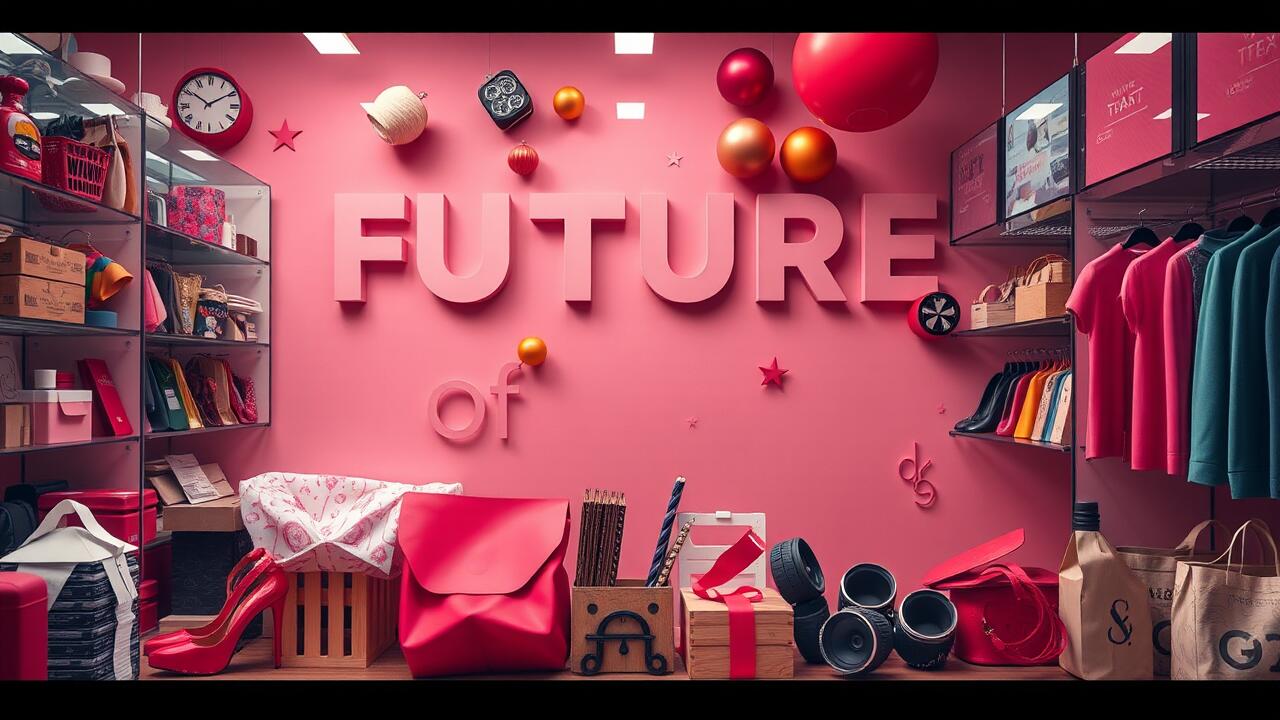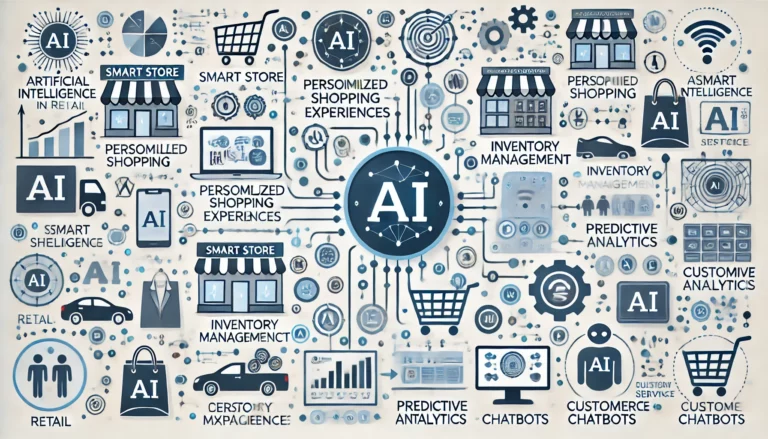Innovative Retail Technology
Big Data Analytics for Retail
The retail landscape is rapidly morphing, increasingly entwined with the intricate web of big data analytics—a veritable lifeline for gaining that elusive competitive edge. Picture this: retailers harnessing vast oceans of consumer data, diving deep into the murky waters to unearth insights about customer preferences and purchasing whims. With these revelations in hand, businesses can craft marketing strategies so finely tuned they resonate like a perfectly strummed guitar string, transforming the shopping experience into something profoundly personal—one that not only satisfies but cultivates unwavering brand loyalty.
But wait—there’s more! The evolution of big data analytics tools has revolutionized how retailers anticipate trends and streamline their inventory management processes. Imagine analyzing past sales alongside the ever-shifting currents of current market dynamics; it’s like having a crystal ball at your fingertips! Armed with such intelligence, companies can deftly navigate decisions surrounding stock levels and product assortments. This forward-thinking mindset acts as a safeguard against the perils of overstock or understock dilemmas—bolstering operational efficiency while boosting profitability in ways previously thought unimaginable.
Leveraging Data for Informed Decision Making
Retailers stand at the precipice of transformation, poised to amplify their decision-making prowess through the labyrinth of big data analytics. Imagine sifting through an ocean of consumer insights—each tidbit revealing a tapestry woven from shopping habits and preferences. This profound comprehension allows businesses to sculpt marketing strategies and product lines with surgical precision.
In this whirlwind of real-time information, companies gain the uncanny ability to predict demand fluctuations, fine-tune inventory management, and slash waste like never before, all while boosting operational efficiency to new heights.
But wait—there’s more! Enter predictive analytics, that enigmatic ally in strategic planning’s arsenal. Retailers can delve into historical data archives, mining for trends lurking beneath the surface or pinpointing potential hiccups within supply chains—all while nimbly adapting to market shifts as if dancing on a tightrope. With cutting-edge analytics tools at their disposal, businesses can unveil intricate patterns that shape pricing tactics and promotional blitzes alike. In a world where change is rapid-fire, staying competitive becomes less about luck and more about leveraging data-driven insights that empower retailers to not just keep pace but lead the charge in fulfilling customer desires with remarkable accuracy.
The Role of Automation in Supply Chains
Automation has surged to the forefront as an indispensable catalyst in amplifying supply chain efficiency. Imagine a symphony of advanced technologies—robotics pirouetting alongside artificial intelligence, all choreographed to optimize inventory management while slashing operational costs. These automated systems are like vigilant sentinels, orchestrating stock levels in real-time, predicting demand with uncanny accuracy, and enabling laser-focused order fulfillment. The result? A significant reduction in human error paired with turbocharged response times that dance elegantly around market fluctuations, crafting a supply chain that’s not just responsive but downright agile.
But wait—there’s more! Automation doesn’t merely streamline processes; it revolutionizes communication across the multifaceted strands of the supply chain tapestry. Picture interconnected systems creating a fluid exchange of data where information cascades seamlessly from one stakeholder to another like water flowing down a mountain stream. This newfound transparency acts as a bonding agent for collaboration, empowering organizations to preemptively navigate disruptions—whether they stem from supplier hiccups or sudden shifts in consumer appetite. As the labyrinthine nature of supply chains continues to evolve and grow ever more intricate, automation emerges not only as a remedy for these complexities but also as a strategic weapon for maintaining that elusive competitive edge.
Streamlining Operations with Technology
The landscape of supply chain management in the retail world is undergoing a radical transformation, fueled by automation and cutting-edge software innovations. Picture this: with the infusion of artificial intelligence and machine learning, businesses are now able to peer into the future, predicting demand fluctuations with an uncanny accuracy that was once deemed impossible. This newfound foresight empowers retailers to fine-tune their inventory levels, slashing excess stock like a master chef slicing through overripe fruit.
But wait—there’s more! Automated systems are not just about prediction; they offer real-time tracking of shipments that ensures deliveries arrive right on schedule. Imagine customers eagerly awaiting their packages, satisfaction soaring as each delivery lands precisely when promised.
And let’s talk collaboration—oh yes! Embracing technology within operations fosters a spirit of unity among departments that might otherwise operate in silos. Platforms designed for seamless information sharing can obliterate communication barriers between procurement, inventory management, and sales teams. With integrated software at their fingertips, retailers are primed to react swiftly to market shifts and evolving consumer tastes—a dance of agility that keeps them ahead of the curve.
This harmonious orchestration doesn’t just enhance efficiency throughout the supply chain; it propels business outcomes into new realms of success. So buckle up—the retail sector is changing faster than ever before!
| Technology | Benefit | Example Use Case |
|---|---|---|
| Artificial Intelligence | Predicts demand fluctuations | Using AI algorithms to analyze purchase history and forecast future sales |
| Real-Time Tracking Systems | Ensures timely delivery of shipments | Implementing GPS tracking for orders, allowing customers to monitor their delivery status |
| Integrated Software Platforms | Enhances collaboration across departments | Utilizing cloud-based systems to share inventory levels between sales and procurement teams |
| Automation Tools | Improves operational efficiency | Automating reorder processes when stock levels fall below a specified threshold |
Sustainability and Retail Tech
The intertwining of technology and retail has emerged as a critical driving force behind the quest for sustainability. Retailers, in a bid to tread more lightly on our planet, are increasingly embracing digital tools that allow them to monitor and trim their carbon footprints with precision. Picture this: energy-efficient lighting systems flickering optimally alongside smart inventory management software—these innovations don’t just slash costs; they also curtail waste like never before. With these technological marvels at their fingertips, stores can hone their resource usage, paving the way for eco-friendly practices that resonate deeply with consumers who care about Mother Earth.
But wait—there’s more! The burgeoning embrace of circular economy models in retail showcases an unwavering dedication to sustainability through tech-savvy means. A growing number of companies are tapping into platforms designed for product take-back schemes and robust recycling initiatives. By harnessing digital solutions, retailers transform returns into effortless transactions while nudging consumers toward engaging actively in sustainability endeavors. This dynamic not only fortifies brand loyalty but also nurtures a sustainable consumption cycle—a telling sign of the shifting tides in consumer expectations towards businesses that prioritize responsibility over mere profits.
Implementing Eco-Friendly Solutions
The surge toward sustainable retail practices is picking up steam, a veritable wave as companies scramble to sync their operations with the escalating environmental outcry. Retailers are diving headfirst into a sea of eco-friendly solutions—think sustainable packaging that whispers care for the planet, energy-efficient lighting that shines bright yet gentle on resources, and renewable energy sources that promise a greener tomorrow. These initiatives do more than just slice through environmental impact; they strike a chord with consumers who are increasingly discerning about sustainability in their shopping choices.
But wait—there’s more! The embrace of circular economy principles can elevate a retailer’s pledge to sustainability even further. By championing recycling and repurposing efforts, businesses have an opportunity to shrink waste and elongate product lifecycles like never before. And here’s the kicker: when retailers invite customers into these green initiatives, it often sparks brand loyalty—a delightful twist! Consumers tend to appreciate the transparency and genuine effort towards environmental stewardship being woven into the fabric of those brands they choose to support.
Social Commerce Trends
The explosion of social media platforms into the retail realm has sparked a seismic shift in how consumers make purchasing decisions. Social commerce, that vibrant fusion of engagement and familiarity, allows brands to forge genuine connections right at their customers’ fingertips. Imagine shoppable posts popping up as you scroll, live-streaming events bursting with excitement, and user-generated content adding an authentic flair – retailers can now elevate visibility while seamlessly driving conversions. This phenomenon highlights the necessity for crafting a unified experience that not only enthralls audiences but also nudges them toward those quick buying choices.
In this bustling landscape, brands are tapping into influencers and brand ambassadors like never before to amplify their presence within these digital ecosystems. The credibility these personalities exude can dramatically sway consumer perceptions and foster trust in ways traditional advertising simply cannot match. Moreover, social commerce opens up channels for feedback loops that allow brands to capture real-time insights on customer preferences—it’s like having your finger on the pulse of the market! As these platforms continue to evolve, we’ll see an even greater emphasis on personalized marketing strategies and bespoke shopping experiences shaping sales tactics across retail fields. This evolution illustrates a thrilling dance between social interaction and commerce—transforming how consumers engage with their favorite brands in truly dynamic ways.
Harnessing Social Media for Sales
Social media platforms have morphed into formidable marketing juggernauts, granting retailers the power to connect directly with consumers in ways previously unimagined. With targeted advertising and influencer collaborations under their belts, brands can deftly hone in on their ideal audiences. This approach not only tailors messages using user data but also significantly boosts the likelihood of conversion—a tantalizing prospect for any retailer.
Moreover, the magic of user-generated content comes into play here, offering a veneer of authenticity that cultivates trust and nudges potential buyers closer to the checkout line. The interactive essence of social media weaves a vibrant tapestry of community and brand loyalty among shoppers—an ecosystem where engagement thrives.
Shoppable posts and live streaming create avenues for real-time interaction, crafting an almost fluid shopping experience. Customers find themselves empowered to reach out to brands at a moment’s notice—questions posed, feedback received instantaneously—enhancing every facet of their shopping journey. As retailers forge ahead into this ever-evolving landscape, grasping the nuances of consumer behavior and preferences will be pivotal for unlocking their sales potential like never before.
- Leverage targeted advertising to reach specific demographics effectively.
- Collaborate with influencers to amplify brand visibility and credibility.
- Encourage user-generated content to build a sense of community and authenticity.
- Implement shoppable posts to streamline the purchasing process directly within social media.
- Utilize live streaming to engage with customers in real-time and showcase products effectively.
- Monitor consumer behavior and preferences to adapt strategies for maximum impact.
- Foster open communication channels to enhance customer service and strengthen brand loyalty.
The Future of Virtual Shopping
The metamorphosis of virtual shopping is poised to radically reshape the retail terrain. Picture this: augmented reality (AR) and virtual reality (VR) whisking consumers into immersive realms, where products can be envisioned right in their living rooms before they even think about hitting that buy button. As these cutting-edge technologies become more commonplace, retailers are diving headfirst into crafting stunning virtual showrooms and interactive escapades designed to elevate customer engagement and satisfaction to dizzying heights.
And don’t overlook the powerhouse that is artificial intelligence (AI); it’s a linchpin for what online shopping will evolve into. Imagine personalized recommendations, meticulously fine-tuned by machine learning algorithms, predicting your every whim—transforming user experience as they cater seamlessly to individual tastes. Meanwhile, chatbots and virtual assistants spring up like digital genies, ready to tackle inquiries and facilitate transactions with effortless grace. This intoxicating blend of tech isn’t merely cranking up efficiencies; it’s also revolutionizing the very way customers connect with brands and products in an ever-expanding digital marketplace.
Innovations Shaping Online Retail Experiences
The digital realm? Oh, it’s a whirlwind of transformation, racing toward an unprecedented age of online shopping experiences that are anything but ordinary—thanks to cutting-edge technologies. Enter augmented reality (AR) and virtual reality (VR), those dazzling game-changers reshaping how customers interact with products. Imagine this: you can actually see items right in your own living room before you even think about hitting that purchase button! Retailers are weaving AR features into their mobile apps like magic threads, allowing shoppers to “try on” clothes or envision where that new sofa might sit—all from the comfort of home.
But wait, there’s more! Artificial intelligence (AI) isn’t just lurking in the background; it’s front and center in crafting a bespoke online shopping experience. With its clever algorithms analyzing customer habits and whims, AI serves up personalized product recommendations tailored precisely for each unique shopper’s taste buds. And let’s not forget those chatbots—powered by AI—they’re working tirelessly behind the scenes to provide instant assistance, making customer service swifter than ever before. The synergy of these vibrant technologies doesn’t merely enhance engagement; it supercharges conversion rates too! It paints a vivid picture of innovation leaving an indelible mark on the retail landscape—an electrifying evolution indeed!
Conclusion
The retail industry is undergoing a seismic shift, driven by the infusion of groundbreaking technology that’s turning conventional norms on their head. Picture this: businesses that throw their weight behind cutting-edge data analytics, automation marvels, and eco-conscious practices are not just surviving; they’re gearing up for sustainable growth like never before. In this whirlwind of change, keeping pace with emerging trends—think social commerce and immersive virtual shopping—isn’t just smart; it’s essential for carving out a competitive niche in an ever-accelerating marketplace.
As we sail through these turbulent waters of transformation in retail, the call for strategic investment in technology rings louder than ever. Organizations that tap into these innovations with finesse can turbocharge operational efficiency while elevating customer engagement to new heights—a win-win scenario! Cultivating a mindset centered around continuous improvement equips retailers to deftly maneuver through obstacles and grasp opportunities as they pop up on the horizon. This proactive approach isn’t just about survival; it’s about laying down the groundwork for enduring success in an unpredictable landscape.






